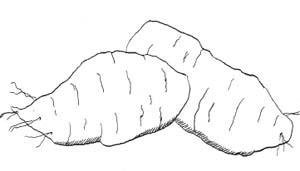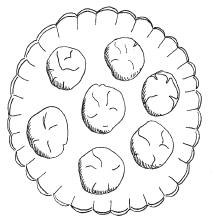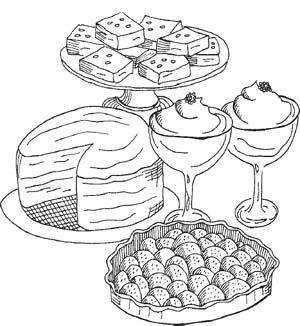Nourishing Traditions: The Cookbook That Challenges Politically Correct Nutrition and The... (146 page)
Authors: Sally Fallon,Pat Connolly,Phd. Mary G. Enig
Tags: #Non-Fiction, #Reference, #Science, #Health
Place almonds in food processor and process until finely ground. Add remaining ingredients and blend well. Form into walnut-sized balls and place on buttered cookie sheets. Bake at 300 degrees for about 20 minutes. After 5 minutes in the oven, press cookies down lightly with a fork. Let cool completely before removing to an airtight container for storage. Store in refrigerator.
After analyzing hundreds of food samples for
trans
fatty acids and calculating dietary information, I have concluded that there are many people in the U.S. who consume 20% of the total fat in their diet as
trans
fatty acids. On average, though, 10.9% of the total fat is the average amount that can be calculated from all the published analyses. In the U.S. typical french fried potatoes have about 40%
trans
fatty acids, and many popular cookies and crackers range from 30 to 50%
trans
fatty acids. Doughnuts have about 35 to 40%
trans
fatty acids. Since these are all high-fat goods, someone who eats a lot of them will get a large amount of
trans
fatty acids. Several years ago we documented nearly 60 grams of
trans
fatty acids in one typical daily diet. More recently, the diet of a young student was found to contain nearly 100 grams of
trans
fatty acids every day because the foods being consumed included a pound of snack chips made with partially hydrogenated vegetable oil. Mary G. Enig, PhD
Know Your Fats
SWEET POTATO COOKIES
Makes about 18
1 cup cooked sweet potato or squash
½ cup butter, softened
¾ cup maple syrup
1 egg
½ teaspoon sea salt
½ teaspoon powdered cloves
½ teaspoon ground nutmeg
1 teaspoon cinnamon
1 teaspoon baking soda
2 cups
bulgur flour½ cup raisins
½ cup crispy pecans, chopped (
crispy pecans
)
Place all ingredients except pecans and raisins in a food processor and process until well blended. Transfer to a bowl and fold in raisins and nuts. Form into walnut-sized balls and place on buttered cookie sheets. Bake at 325 degrees for about 20 minutes. After 5 minutes in the oven, press cookies down lightly with a fork. Let cool completely before removing to an airtight container for storage. Store in refrigerator.
Cholesterol is especially important to our brains. That's right, today's "most hated" substance is essential to the human brain function. In fact, infants need a constant supply of cholesterol during brain development, which is why mother's breast milk is so high in it. Modern science tripped over itself somehow when it named cholesterol the bugaboo of heart disease. Nature doesn't make that kind of mistake—but man does. [Most soy-based infant formulas contain no cholesterol.] Tom Valentine
Facts on Fats & Oils

CAROB CHIP COOKIES
Makes about 18
½ cup butter, softened, or coconut oil
½ cup Rapadura (see
Guide to Natural Sweeteners
)1 egg
½ teaspoon sea salt
½ teaspoon baking soda mixed with 1 tablespoon hot filtered water
1 teaspoon vanilla extract
1
1
/
8
cups
bulgur flour1 cup
carob chips½ cup
crispy pecans
, chopped
Cream butter with Rapadura. Beat in egg, sea salt, baking soda with hot water, vanilla extract and bulgur flour. Fold in carob chips and chopped pecans. Form into walnut-sized balls and place on buttered cookie sheets. Bake at 325 degrees for about 20 minutes. After 5 minutes in the oven, press cookies down lightly with a fork. Let cool completely before removing to an airtight container. Store in refrigerator.
Variation: Date Nut Cookies
Use
1 cup chopped dates
in place of carob chips.
Know Your Ingredients
Name This Product #37
Sugar, enriched flour (contains niacin, reduced iron, thiamine mononitrate [vitamin B1], riboflavin [vitamin B2]), vegetable shortening (partially hydrogenated soybean oil), cocoa, (processed with alkali), high fructose corn syrup, corn flour, baking soda, chocolate, whey, soy lecithin (emulsifier), and vanillin, an artificial flavor.
See
Appendix B
for Answer
Suspected as a migraine causative for decades, chocolate has been cleared on the basis of insufficient evidence. Now things may be changing, thanks to new findings from a study by biochemist Vivette Glover. . .. Twenty heavy migraine sufferers volunteered for the study—12 eating real chocolate and eight eating a carob placebo made to taste identical to the chocolate.
Twenty-four hours after volunteers ate their test samples, five chocolate eaters experienced pounding migraines while the placebo eaters showed no symptoms. Asked what chemicals in chocolate brought on the migraines, Glover said that they had not as yet been isolated. Yet, two of the strongest suspects are catechin, also present in red wine, and theobromine, a biochemical cousin to caffeine in coffee. James F. Scheer
Health Freedom News
RAISIN NUT COOKIES
Makes about 2 dozen
½ cup whole
yoghurt½ cup butter, softened
¼ teaspoon sea salt
1½ cups freshly ground whole wheat, kamut or spelt flour
1 cup Rapadura (see
Guide to Natural Sweeteners
)1 teaspoon vanilla extract
½ teaspoon cinnamon
½ cup raisins
¾ cup crispy walnuts or pecans (
crispy pecans
), chopped
Blend yoghurt, butter, flour and salt. Place in a bowl, cover and leave at room temperature for 12-24 hours. Beat in Rapadura, vanilla and cinnamon until dough is very smooth. Blend in raisins and walnuts. Drop by spoonfuls on buttered cookie sheets. Bake at 350 degrees for about 20 minutes. Let cool completely before removing from pan. Store in refrigerator.
Know Your Ingredients
Name This Product #38
Unbleached wheat flour, partially hydrogenated vegetable shortening (soybean and cottonseed oils), brown sugar, invert syrup, cranberries, raisins, honey, sugar, egg whites, leavening (ammonium bicarbonate, baking soda, cream of tartar), soy lecithin, vanilla extract, salt and orange oil.
See
Appendix B
for Answer
MACAROONS
Makes 2 dozen
4 egg whites pinch of sea salt
2 tablespoons arrowroot
½ cup maple syrup
1 tablespoon vanilla extract
2 cups commercial dried unsweetened coconut meat, finely cut
Line a baking sheet with buttered parchment paper (See
Sources
). Beat egg whites with salt in a clean bowl until they form stiff peaks. Beat in the arrowroot and slowly beat in syrup and vanilla. Fold in coconut. Drop by spoonfuls on parchment paper. Bake at 300 degrees for about ½ hour or until lightly browned. Reduce oven to 200 degrees and bake another hour or so until macaroons are completely dry and crisp. Let cool completely before removing from parchment paper. Store in an airtight container.
It can be seen from a simple inspection [of the statistics] that cholesterol levels [are] apparently more closely related to sugar consumption than to fat consumption. For instance, it can be seen that two countries with the highest fat consumption, Spain and Ethiopia, had two of the lowest national blood cholesterol levels. However, these two countries with high fat consumption levels both had very low sugar consumption levels. On the other hand, two countries, Chile and Venezuela with high sugar consumption levels but with relatively low national fat consumption levels, had two of the highest national blood cholesterol levels. Chris Mudd
Cholesterol and Your Health


Sugary sweets are the bane of the civilized world, wreaking havoc on the health of young and old. Commercial sweets contain not only refined sweeteners—usually sugar or corn syrup—but also white flour along with highly processed and hydrogenated oils. And most contain little in the way of whole foods to compensate for these empty calories.
Yet it is perfectly possible to satisfy our inborn taste for sweet things with desserts that are nutritious. We offer here a selection of recipes featuring eggs, butter, cream, fruit, nuts and whole grains that have been soaked or fermented, along with moderate amounts of natural sweeteners. Natural sweeteners contain high amounts of minerals and other nutrients. Acceptable processed natural sweeteners are those in which the nutrients have been concentrated through boiling or dehydration rather than stripped away, as in white and brown table sugar, corn syrup or fructose.
Individual reactions to sweeteners, even and especially natural sweeteners, vary widely. Reseacher William H. Philpott found that many individuals experience a rapid rise in blood sugar when they consume one sweetener but not another. He cites the example of a patient whose blood sugar skyrocketed when she ate any corn product; but who could eat ordinary white sugar with no rise in blood sugar levels. (This does not mean that white sugar was good for her.) It is wise to test your pulse before and after eating various sweeteners to see if any provokes a reaction. Some physicians have found that fructose in corn syrup provokes more consistently severe reactions than sucrose in table sugar.
With sugar so cheap and plentiful, we have lost sight of the fact that desserts are something that you "deserve" and should not be eaten on a daily basis. Even naturally sweetened desserts should be eaten only occasionally. We recommend you limit your dessert-making to holidays and special occasions and perhaps one or two evening meals per week. A good idea is to make dessert on nights when you are serving fish or liver or some dish your children might be reluctant to eat, and offer dessert as the prize for clean plates.
Most authorities recommend that sweets be eaten after a meal and never on an empty stomach when the sudden infusion of sweetness can send the blood sugar racing upwards; however, a minority opinion asserts that sweet things, especially those containing milk products, like ice cream should only be eaten between meals, so that they have less time to ferment in the stomach. The best advice we can give in the face of these conflicting opinions is to limit your intake of sweets and never eat anything that is too highly sweetened. Finally, never eat sweet things without some fat to accompany them—whether it be cream on fruit or in ice cream, or butter and eggs in cakes and pies. Fats like butter, cream and egg yolks slow down the absorption of sugar into the bloodstream while providing fat-soluble nutrients that nourish those glands involved in the blood sugar regulation mechanism.
Avoiding sugar and keeping it away from your children is one of the most difficult things that parents are called upon to do in modern life. It is a challenge that requires discipline, planning, creative alternatives and cunning strategy. The following tips may help you in the never-ending battle:
Don't keep sweets around the house, even if you yourself have the willpower to resist temptation. Children will find their way to candies, cookies and other sweet snacks if they are available.
Never shop when you are hungry.
If you crave sweets after meals, try a handful of
crispy pecans
or
cashews
, both of which have a sweet taste. Author Nancy Appleton suggests brushing your teeth immediately after meals as the sweetness of toothpaste may be just enough to conquer cravings. A lacto-fermented beverage taken with meals also helps eliminate postprandial cravings.
Don't forget to enlist the power of prayer in your battle against the sweet tooth.
Make your children's school lunches. Unless their school policy is very enlightened, their school lunches will be loaded with sweet things.
Never send a child to a birthday party or a sleep-over on an empty stomach; but fortify him beforehand with a large and nutritious sandwich or snack.
Be resigned to that fact that you cannot keep sugar away from your children entirely. Don't make a fuss when they eat sweets and junk foods occasionally while they are with friends or you might give them good reason to rebel. You can protect them from occasional use of sugar by a diet that is consistently nutritious. When they are old enough, be sure to explain just why sugar is so bad for them. Remember that
your
example is your child's best guide to his adult eating habits.